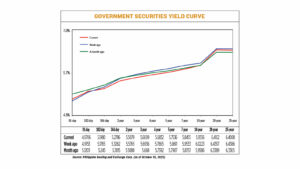YIELDS on government securities (GS) ended mostly lower last week after the Bangko Sentral ng Pilipinas (BSP) surprised the market by delivering a fourth consecutive rate cut.
GS yields, which move opposite to prices, declined by an average of 5.32 basis points (bps) week on week, according to PHP Bloomberg Valuation Reference Rates data as of Oct. 10 published on the Philippine Dealing System’s website.
Rates at the short end were mixed as the 91- and 182-day Treasury bills (T-bill) rose by 5.53 bps and 2.15 bps week on week to end at 4.9706% and 5.198%, respectively, while the 364-day T-bill fell by 4.76 bps to yield 5.2786%.
Meanwhile, yields at the belly and the long end went down across all tenors. The two-, three-, four- five-, and seven-year Treasury bonds (T-bonds) dropped by 6.86 bps (to 5.5079%), 9.27 bps (5.6009%), 10.33 bps (5.6832%), 10.75 bps (to 5.7536%), and 10.78 bps (5.8455%), respectively.
Yields on the 10-, 20-, and 25-year bonds also declined by 6.67 bps (to 5.9556%), 2.95 bps (6.4102%), and 3.78 bps (6.4008%), respectively.
Total GS volume traded amounted to P148.2 billion on Friday, jumping from the previous week’s P24.28 billion.
Debt yields went down week on week after the BSP unexpectedly lowered benchmark borrowing costs, analysts said.
“The bond market welcomed the move as the local bond curve bull steepened, trading lower by 8-30 bps, with the belly of the curve benefitting the most,” said Dino Angelo C. Aquino, vice-president and head of fixed income at Security Bank Corp.
“The CPI (consumer price index) was higher versus the previous month but was lower than market consensus of 2%. The lower print likely was a factor in the BSP’s decision to unexpectedly cut rates to focus on growth as inflation remains below their target of 2-4%,” he added.
He said the bond auction last week was a non-event as the market’s focus was on the central bank meeting.
“Foreign flows were seen coming back to the GS market after the surprise cut. They were mostly sellers the past few weeks, and their full 180-degree turn helped fuel the market rally.”
A bond trader likewise said that “everything changed because of the rate cut.”
On Thursday, the Monetary Board cut benchmark borrowing costs by 25 bps for a fourth straight meeting, bringing the policy rate to 4.75%. Only six of the 16 analysts polled by BusinessWorld predicted the reduction.
It has now lowered rates by a total of 175 bps since it began its easing cycle in August 2024.
BSP Governor Eli M. Remolona, Jr. said their decision to cut came amid benign inflation and softening growth prospects due to weakening investor confidence due to a widening corruption scandal involving government infrastructure projects.
Inflation picked up to a six-month high of 1.7% in September from 1.5% in August, bringing the nine-month average to 1.7% — still below the central bank’s annual goal.
Mr. Remolona said another rate cut is possible at their last policy meeting for this year on Dec. 11, with more reductions beyond that also on the table.
For this week, Mr. Aquino said GS rates may continue to go down.
“With key resistance levels broken for the five- to 10-year tenors and levels touching new year-to-date lows, we expect this rally to have some legs and yields biased to move lower,” he said.
“We continue to see a downward trend as no fresh supply is expected [this] week,” the trader added.
“From our end, the BSP just confirmed our in-house call that growth might be overstated due to the recent corruption scandal. So, that will also affect the outlook as the government tries to clean up the mess.” — Matthew Miguel L. Castillo

